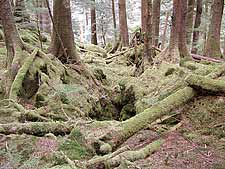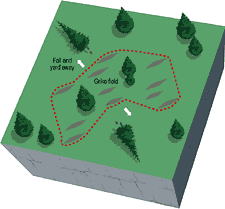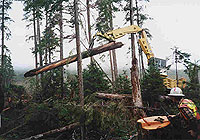Karst management and timber harvesting (lesson 7)
On this page
Learning objectives
This lesson discusses how the karst management principles you have been exploring can be applied to timber harvesting. By working through this lesson you will be able to:
- Recognize the major challenges and issues involved in harvesting timber on karst terrain
- Identify best management practices for harvesting timber, based on the vulnerability of the karst
Introduction
As you work through this lesson, you will understand how timber harvesting can be modified to accommodate the assessed vulnerability of a karst area.
Issues and challenges
- What are some of the management issues associated with timber harvesting on karst terrain?
- Minimizing the disturbance of karst soils to prevent soil erosion and sediment transfer into subsurface karst environments
- Maintaining surface and subsurface water quality and quantity
- Maintaining stable microclimates around significant cave entrances
- Maintaining critical karst surface processes above significant caves
- Protecting significant surface and subsurface karst features
- Protecting and conserving karst-dependent flora and fauna
- Maintaining recreational values of significant surface karst features and cave entrances
Example of a karst ecosystem.

Best management practices
Low vulnerability areas
The following best management practices are recommended:
- Conduct safety briefings for appropriate personnel
- Flag karst features and/or values within the operating area
- If previously unidentified karst features or values are encountered, modify or cease operations until the features or values can be assessed. Notify the local Forest Service district office
- Minimize exposing mineral soil as much as possible
- Locate storage areas for fuel and other hazardous materials off karst terrain or at least on low vulnerability karst areas (except for daily fuel requirements)
Moderate vulnerability areas
In addition to the recommendations for low vulnerability areas, the following best management practices are recommended on moderate vulnerability areas:
- Consider restricting harvesting to periods when the likelihood of heavy rains and high runoff are low
- Consider developing site-specific procedures for closely spaced, dense occurrences of minor surface karst features (for example, falling and yarding away from features, retaining non-merchantable vegetation, removing logging debris from features, etc.). In some cases it may be practical to treat a cluster of minor features as a single unit
NOTE: Minor surface karst features – surface karst features of relatively small size, rarely more than five metres in the greatest dimension (for example, karren, small sinkholes, grikes, residual pinnacles, or other surface solutional features).
- Avoid disturbing sideslopes and soil as much as possible when harvesting around sinkholes that do not require a reserve (for example, fall and yard away, retain non-merchantable vegetation, maximum suspension yarding). Harvesting sinkholes with >70% sideslopes should be carried out very carefully due to the high potential for soil erosion
- Where falling away from a sinkhole cannot be reasonably achieved, and remaining trees threaten sideslope stability due to windthrow potential, consider falling across the sinkhole if the tree stem will span the feature and can be lifted without damaging the sideslope. If removal will damage residual trees or sideslopes, leave the section of stem spanning the feature, provided it is stable
- Consider the following when trying to recover logging slash and debris from sinkholes:
- Clean out debris only if it will not cause further disturbance
- Avoid using heavy machinery if damage to sideslopes might occur
- Follow machine cleaning with hand cleaning if necessary
- Leave naturally fallen trees
- Do not remove stable natural material embedded in sinkhole sideslopes or root systems that contribute to sideslope stability
- Keep the wheels or tracks of equipment at least 5 metres from the edge of karst features. If not possible, keep wheels or tracks parallel to the edge of features
- Take appropriate measures to correct inadvertent water diversions to prevent sediment transfer into subsurface environments
- Use protective mats to minimize soil disturbance when hoe chucking
- Keep skid trails and backspar trails to a minimum and located away from surface karst features and cave entrances
- Minimize the potential for soil disturbance through maximum suspension yarding
- Avoid fueling or servicing machinery near surface karst features and cave entrances. Take appropriate measures if spills occur
Treating a cluster of minor surface karst features as a single unit.

Self check questions
Answer either True or False to check your understanding:
- A major challenge when harvesting timber on karst is to minimize soil disturbance to prevent soil and sediment transfer to the subsurface
- Protective rubber mats are recommended when using a hoe chucker on low vulnerability areas
- Helicopter logging may be an appropriate option for harvesting on well-developed epikarst
Self check answers
- True
- False
- True

